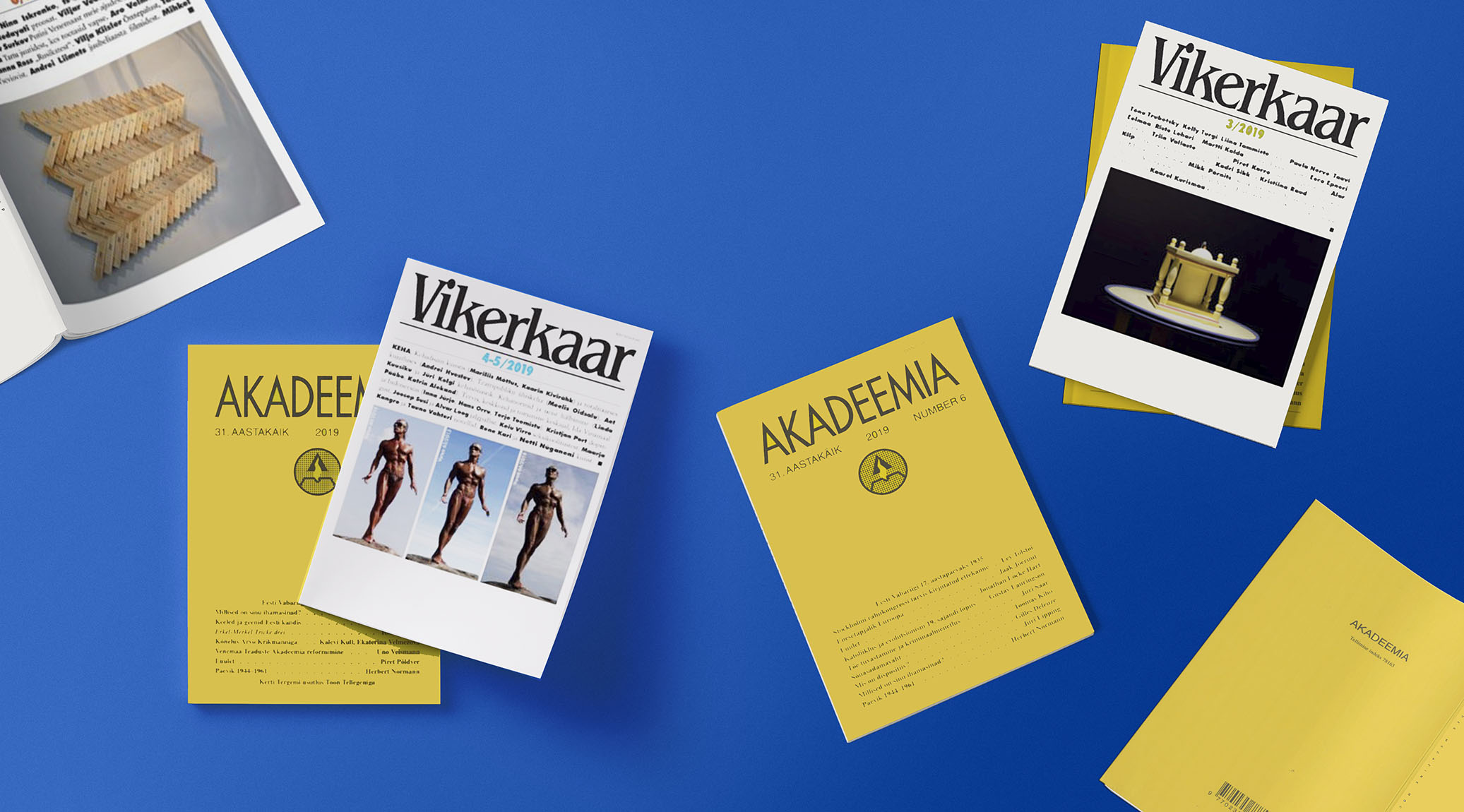The deliberate provocative title of this article is necessary if only to focus the reader’s attention on two, globally marginal, points that combine to form a single, hyper-marginal issue. For western Europe, Estonia is a tiny country situated somewhere on the edge of eastern Europe. According to at least one Dutch geography primer, the country doesn’t even exist. There is also the inevitable question among the international editors: who cares?
This is echoed in the second marginal point: the question of culture. By ‘culture’ I mean the self-evident, everyday environment of people’s actions and their source of meaning. This is also visible, in a concentrated form, in professionalized culture. No thanks to our current information overload, this concept of culture competes with ideas that seem more exciting, and rarely receives the public’s full attention. Yet it could be said that, by examining these two marginalities more closely, we might find something entertaining here, too. This is especially so since the cultural reservation in Estonia is, to some extent, quite different to many other European countries. But first, a few words on the lesser-known economic and social context.
Conserving the core of culture while assuring its diversity
Every year, the Estonian Republic sets aside a decent sum of its budget to support cultural institutions. In the funding of Estonian cultural output, one might note one cramped and idealistic way to preserve the world’s cultural plurality. As Yuval Noah Harari has written in his provocative Sapiens: A Brief History of Humankind, human history has seen the general reduction of human diversity: small peoples have been incorporated into the more able and aggressive peoples.
I myself have noted that even those able to claim a cultural identity, like German speakers, worry about the threat of dying out and disappearing. Nations that lack the defending embryo of the state are even more exposed to the cold winds of global culture. So far, it seems that, in order to keep preserving a culture, mobilizing resources under the protective wings of the state is one of the few strategies for creating a retrograde movement against homogenization and standardization.
In Estonia, the promotion of culture also involves a support system for cultural journalism. A foundation has been created for this purpose (S.A. Kultuurileht cf. sidebar). It receives endowments from the national budget and backs the financial management of sixteen cultural papers and publications. They include: publications for children, youth culture, and young poets, newspapers in an Estonian dialect and relating to the cultural sphere, an academic research publication, a journal introducing readers to global social and political thought, and many others. The picture is rather scattered and, over the years, the list has only broadened. Not everyone is happy about this, however, since the subsidies don’t increase and resources are spread thinly.
Publications supported by S.A. Kultuurileht (The Foundation for Cultural Publication’)
Akadeemia – original research and translated texts in the social sciences and humanities
Diplomaatia – a monthly journal of foreign affairs
Hea laps – a children’s magazine
Keel ja Kirjandus – an academic publication of linguistic and literary research
ee – a journal of the arts
Looming – contemporary prose and poetry
Loomingu Raamatukogu – a series of periodicals providing Estonian translations with the newest in world literature
Muusika – a journal of music
Müürileht – a cultural journal with a youth audience
Sirp – a weekly paper dealing in various cultural fields and current affairs
Muusika. Kino – a journal belonging to a creative union in the fields of theater, music, and cinema
Täheke – a children’s journal
UMA Leht – a newspaper in the South Estonian dialect
Vikerkaar – a monthly journal of contemporary social and philosophical thought
Värske Rõhk – a journal of young writers
Õpetajate leht – a weekly newspaper aimed at teachers
Publications of S.A. Kultuurileht are issued on paper, and circulation can reach from around one hundred to five thousand. The print run of the journal Sirp, for example, has stayed at the top of this range – quite large, considering the population of Estonia (1.3 million). Sirp’s print numbers were, in fact, fifteen times larger in the early 1990s, when culture was a socially-important instrument of the national self-consciousness that helped bring about Estonian independence from the Soviet Empire. But it was important even before perestroika.
As the most authoritative researcher of Estonian cultural journalism, Marju Lauristin has stated, ‘Cultural journalism was visible, and at the time was able to replace a missing political public sphere in an ideologically suppressed society.’ Clearly, the meaning of cultural discussion has changed since then.
S.A. Kultuurileht does not support any electronic media. Nor does it broadcast programs. Cultural publications have web editions, though their quality differs greatly and they feel rather archaic, since they do not make full use of online interactivity and the advantages of digital media. Almost all of these publications also have their own social media pages, though they are maintained haphazardly, poorly considered, and unattractive to most young readers.
In the past decade, the wider readership of cultural publications has remained callous to the transition to the web. Such a change would have made it possible to widen the potential audience for publications with smaller target demographics, though it is clear that sixteen separate digital transformations would demand a large investment. Even today, this investment has not appeared, more important being, at least, to maintain the status quo – avoid losing our present diversity in cultural resources.
Regardless of the current conditions, the foundation has ready cash, and all of the editorial boards of S.A. Kultuurileht’s publications remain independent, moulding the content of their work in response to the needs of their field. Creative unions (that is, the creators themselves) are responsible for some of this content. Others function on the basis of regular journalistic principles, and a third group is collaborative, attracting citizens.
Commercial publications contain their own cultural sections
Space for cultural sections in commercial newspapers has drastically declined in the last thirty years, replaced with the far more exciting subjects of politics and economics. In the largest Estonian newspaper, Postimees, just two pages out of 24–28 cover cultural events. Another daily paper, Eesti Päevaleht, dedicates three pages to culture at least once a week. Eesti Ekspress, a paper of so-called investigative journalism, publishes a cultural supplement Areen (‘Arena’). There is no great contrast between its content and that publisher in earlier times, when it was bound between separately printed pages. Yet, for its 29th anniversary, the publication used the slogan, ‘Eesti Ekspress on kultuurisõber’ (‘Eesti Ekspress is a Friend of Culture’). This declaration already has its own meaning (see photo). The daily Postimees also publishes an end-of-week supplement devoted to shaping cultural opinion called ‘Arvamus. Kultuur’ (‘Opinion. Culture’).
The situation is worse in private broadcasting. Few if any formats report on cultural events, primarily presenting global popular culture instead, with cultural subjects lost to news programs, a far more entertaining medium. In the last decade, more home-grown television shows have appeared on commercial channels, though they are presented as entertainment and are neither understood nor reflected upon in terms of their meaning or social role.
Only two examples differ to some degree. The radio program Elmaris the only station to exclusively play Estonian music, a rarity in the context of global commercial culture. The commercially funded talk-radio station Kuku, meanwhile, occasionally broadcasts book readings and thought-provoking episodes on other cultural events.
Public media, which is legally obliged to enrich Estonian culture and amplify the voices of minorities, appeals much more to the ‘cultural’ public. There are, both on the radio and television, high-quality series devoted to culture, including a separate program for classical music and a portal for cultural news.
Between 2014-2016, a research group at Tartu University’s Institute of Social Studies mapped this diversity under very different parameters. It looked into the content of cultural journalism and the expectations of audiences, creative individuals, and cultural journalists themselves. Our question was: ‘What kind of role does cultural journalism play in Estonia today, and how?’ Regardless of the small size of the Estonian cultural sphere, our methodological framework posed a serious challenge to the research. How is it possible, we asked, to get a many-sided picture of the phenomenon of cultural journalism, and how can it be seen as a whole?
The functions and spokespersons of cultural journalism
It is quite obvious that different audiences and parties play different roles in cultural journalism. Cultural journalism may be: (a) a method of sustaining cultural discussion and a source of cultural thought for general life, (b) a feedback channel for the intelligentsia, (c) a channel of cultural sales to the public, or (d) a socializing and explanatory force of other cultures for future generations. There is no hierarchy among these tasks. Nor can it be claimed that anyone supersedes another. Different channels fulfil different functions, which themselves change over time.
For the study, our research team combed through Estonian media output. We demonstrated that much of the culturally-themed material appeared in short journalistic forms (short news and announcements). This is, to be exact, the primary form of so-called mainstream media.
Is the reason for this, perhaps, a need on the part of nationwide papers and websites to be their own kind of cultural mediators, or cultural salesmen? Do they, too, work under the jurisdiction of the market, while also being located in a market of specifically cultural events and products? This is, unfortunately, not currently practiced, as their present goal is to draw attention to cultural events and connect new audiences with them. However, next to cultural promotion, there is a deeper role for public thinkers, though texts at this level are published mainly by chance.
The role of political criticism is more clearly visible in the content of S.A. Kultuurileht’s publications. It is remarkable that those publications which have to survive on the state budget are the most critical of cultural politics. Nor has S.A. Kultuurileht muzzled its publications. In contrast, work at that level of critical depth is rare in commercial mainstream media, where there is hardly any measured criticism of cultural events, products, or creators. These two roles – critical scepticism and cultural promotion – have not been brought under one umbrella very well, however.
The cultural content of legacy media in the table below often clearly fits into cultural subcategories: literature, theatre, music, and so forth. Sub-marginal compartmentalization limits more marginal events and reporting on innovative cultural phenomena, since the appropriate theme does not fit one category or another. Take modern dance, for example. This form is neither ‘theatre’ nor ‘art’ alone. In the case of content, the large, formerly reading-based centre of Estonian culture stands out in legacy media.
However, cultural production mixing existing areas of knowledge attracts web-based media, where the borders are not so strict and the formats for presenting content can be quickly swapped or integrated with others.
Broadcast media, on the other hand, privileges visually-appealing cultural products, often with global broadcast potential, turning viewers’ attention largely away from the written word. In just this way, digital culture provides advantages for the general cultural sphere as it opens access to different voices. Cultural producers’ voices are, thus, heard more on online portals. As before, journalistic ‘gatekeeping’ occurs in traditional media, where professionals execute their historical role in deciding what information counts as ‘news’ to their audience and what does not.
The web could be an opportunity for cultural journalism
Cultural conversations can be found on the internet as much as on institutionalized platforms like public cultural portals. Finding sporadic discussions on ‘walls’ and social media feeds is just as likely. It is remarkable that, in the light of Estonia’s state-wide digitalization, the country’s cultural journalism has not made a robust transition to digital platforms. If this were to take place, it small start-ups and individual entrepreneurs would need to prepare for the changes. S.A. Kultuurileht has not, however, received the kind of financial assistance that would allow for all sixteen of its publications to be transferred to interactive platforms. We can ask if this would even be desirable for them. Rather, despite worries that it would be devalued, the group’s content is held, available, before the eyes of small interest groups.Then there is the question whether printed cultural texts printed are fit for online publication. As Vikerkaar Chief Editor Märt Väljataga once put it, web-based texts have their own poetics.
Commercial cultural journalism, like journalism in general, still does not have a sustainable business model for funding content production. Printed newspapers have had a loyal audience of subscribers remains partially intact even today, though the reading public has become habituated to finding content for free online, forcing the next step to become paid content. No one sees a reason to charge money for those texts which lack an obvious necessity, except, for example, films offered by services like Netflix, for which payment doesn’t seem unreasonable.
New ideas and innovative discussions circulate more easily on internet platforms, though, on the other hand, these platforms have more sinister undercurrents. Culture-focused blogging communities conducted on social media are a good example of social media ‘bubbles’, where commentary on cultural events is known only to the small community of networked account holders. These conversations are not inclusive. Social media is, thus, not a public forum. Another worry relates to their sporadic and chance nature. Even if these conversations were opened – visible to anyone with access – then it would be so only under certain conditions. That is, it would depend on the extent to which the conversation could be held to a new standard, assuming users already know the primary questions circulating in a certain cultural field. A rich cultural memory, taken into consideration over the course of discussion, integrates new ideas while letting participants reach deeper levels of understanding. Discussions on social media do not offer such possibilities. The format is rushed, short, and rhetorical.
The intelligentsia does not find fault in journalism
The fifty experts and creative individuals we interviewed represented a cross-section of the roles and operational niches in their local creative fields. Among them were writers, cultural critics, scientists, museum directors, analysts, teachers, choir directors, and others. All engaged wholeheartedly in their fields as ‘cultural caretakers’.
Their general opinion of Estonian cultural journalism was positive. Participants generally rated it as ‘diverse’ and ‘well-functioning’ with regards to their current limited resources. It could be said that, in their feedback, the greatest number of respondents were pleased in the field of theatre, generally happy with the field of music, but less so with literature, film, and dance. Opinion on architecture and visual arts depended on what was seen as the purposes of their responses.
The Grand Old Lady of Estonian social sciences and politics, Professor Marju Lauristin:
‘Talking about the general role of cultural journalism – traditionally, cultural journalism has largely affected the taste of its audience, the formation of opinion, giving critical feedback to artists, and tracking cultural life and events. However, in today’s commercialized, digitalized, and globalized media environment the role of cultural journalism has notably widened. Within it, alternative and casually politicized uses of mainstream media can be seen, as well as the conservation of intellectual values such as profundity, erudition, intelligence, endurance, and discernment.
It seems that the main role of cultural journalism today is the continual self-assessment or lasting autopoeisis of the professional arts and cultures. Not in order to criticize or provide feedback, but as a form of self-searching, not only collectively but on a larger scale worldwide. As well, a cultural-political dimension – that is, the institutional side of cultural process – has entered the picture. The social discussion itself has once again become present in the pages of cultural journals.’
https://www.kul.ee/et/uudised/marju-lauristin-kultuuriajakirjanduse-roll-olla-uhiskonna-ja-kultuurielu
Interviewees in the field of cultural journalism clearly discerned two purposes in their sphere of work: marketing and education. On the one hand, newspapers (and, to some extent, cultural publications) support, in their opinion, the prioritization of the function of the ‘creative industries’. Many reporters express gratitude for cultural marketing, because creative individuals compete amongst themselves for press-attention and carefully keep track of who gets the limelight and for how long. On the other hand, however, the mission of cultural journalism is to educate and enlighten the public. Cultural journalism is not highly valued as a source of artistic feedback. In this respect, cultural journalism lacks intelligibility. Responsibility for this lies partially in creative producers’ inadequate interest in making their opinions known through cultural journalism, though sometimes choices made by cultural journalists themselves play a role, too. According to many experts, the state of cultural criticism in Estonia is quite poor.
Nevertheless, creative producers consider some media channels more important than others. In some respects, this gives us a better picture of what is happening in other cultural fields to measure the temperature of popular opinion and the mindset of wider society. For example, notable professionals in the creative industries are interested in outlets like Sirp, Vikerkaar, and the culture-centred webpage (kultuur.err.ee) of the Estonian Public Broadcasting Corporation (Eesti Rahvus Ringhääling, ERR). An analysis of the readability of Sirplets us guess that the paper mainly interests readers who already think cultural life is important as a field of communication and arbiter of public opinion. The culture page of E.R.R., however, is one of the main sources for the news of cultural events, which professionals find especially important as a regular source of information.
What does the audience of culture expect?
Compared to the Soviet period, the meaning of ‘folk’ and ‘professional’ creative production has certainly changed in Estonia. The world is open: various cultural ideas, experiences, and ways of life are, within arm’s reach for nearly everyone. The need to secure identity through a narrowly strict folk culture or professional cultural production is no longer inescapable as it was under the Soviet Union, when it had been a means of resistance against homogenization into ‘homo soveticus’.
Close to a quarter of Estonians form an active cultural audience. We described this audience in our study as those interested in culture and active in many fields (26% of adult Estonians with an average high education and income, who have an urban lifestyle, active work life, hobbies, and are mobile inside and outside of Estonia). They show diverse patterns of cultural consumption and participation, regularly reading four to five cultural publications, going to concerts, plays, museums, and exhibitions.
It should be noted that the theatre-going public in Estonia numbers among the highest in Europe.
In addition to an active cultural audience, the study exposed other patterns of cultural relations within Estonian society: (a) those traditionally active in literary pursuits, whose participation in culture is limited to private spaces and the solitary enjoyment of literature (16% of adult Estonians, half older than 55); (b) a sizeable amount readers of exclusively digital material, who follow culture far less and are more oriented towards sport and mass cultural events (23%, largely young people, often men); (c) a good amount of those interested in culture through broadcast media, whose participation in culture occurs largely through mediated sources (19%); (d) those not especially interested in culture, who don’t participate in cultural events and do not follow cultural channels (16%).
The greater part of those who regularly follow cultural publications are those with college degrees, higher social statuses, and those interested in traditional culture. Apparently, what cultural journalism offers suits their taste best. The current cultural discussion in the Estonian language is oriented to an audience of erudite, middle-class readers with interests in traditional culture. We can see that the consumption of cultural publications emerges from practical activity in culture. If I have seen a play, then I might read what a critic thought about it. From another angle, the consumption of cultural publications assumes an interest in sharing cultural experiences with others to discuss the greater cultural and social issues. Additionally, even among the youngest respondents, there are those interested in culture and active in many fields, and thus also those who will be socialized into culture itself.
The results of this study clearly show that the social influence of cultural publications cannot be measured through the readership statistics of one publication or another. The factors most adequately explaining the influence of a cultural publication are its readership and credibility among a culturally active audience. What matters most is those whose comprehension, expectations, opinions, and choices these publications effect and reflect.
Final remarks
What can we conclude from all this? Does cultural journalism build walls upon the cultural ecosystem of Estonia and hawkishly guard the preservation of ‘the good old days?’ We can see that this is mostly not the case. Daily competition between producers over meaning and interpretation, and for people’s attention in a globalized world, exerts pressure on cultural media. Estonian culture, and a large part of Estonian cultural journalism, does enjoy the support it needs to function, paid for and secured at the national level. This has not been cause for its entrapment, though. The new comes in and the new goes out; culture blends and renews itself.
The spokesman for Estonia’s new creative identity, writer and biologist Valdur Mikita, has found that the existential question for culture lies in whether or not it is able to integrate the innovations necessary to sustain its core and characteristic differences. To answer this challenge, while at the same time finding the power to check inherently antithetical tendencies, remains an age-old task for culture. Such is the marvellous paradox of social existence, which manifests in culture – within Estonian culture too, in all of its beauty. Very much alive, Estonian cultural journalism reflects and amplifies this, and holds a dialogue with it.








